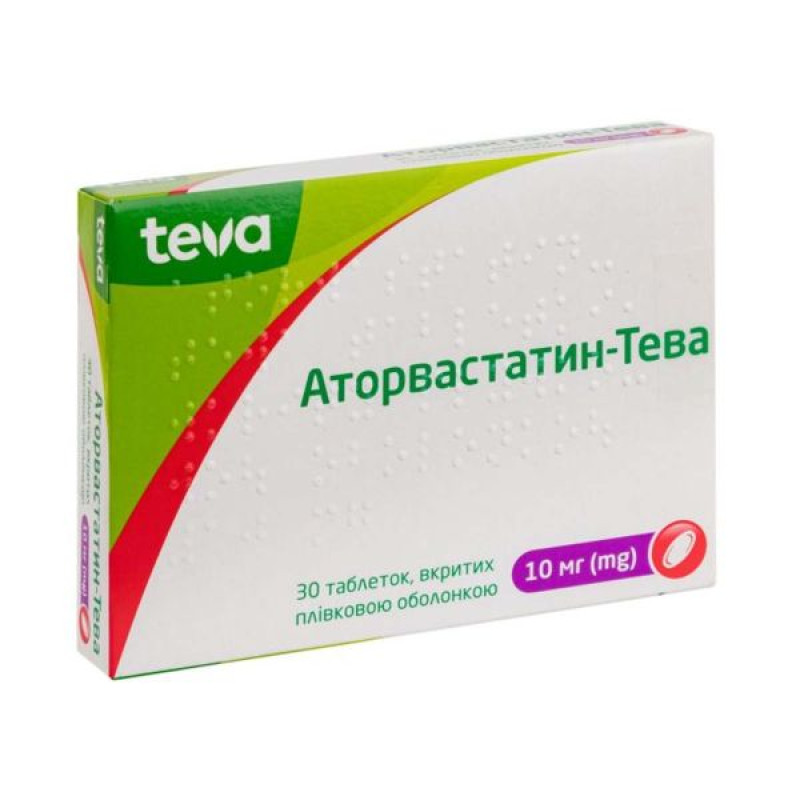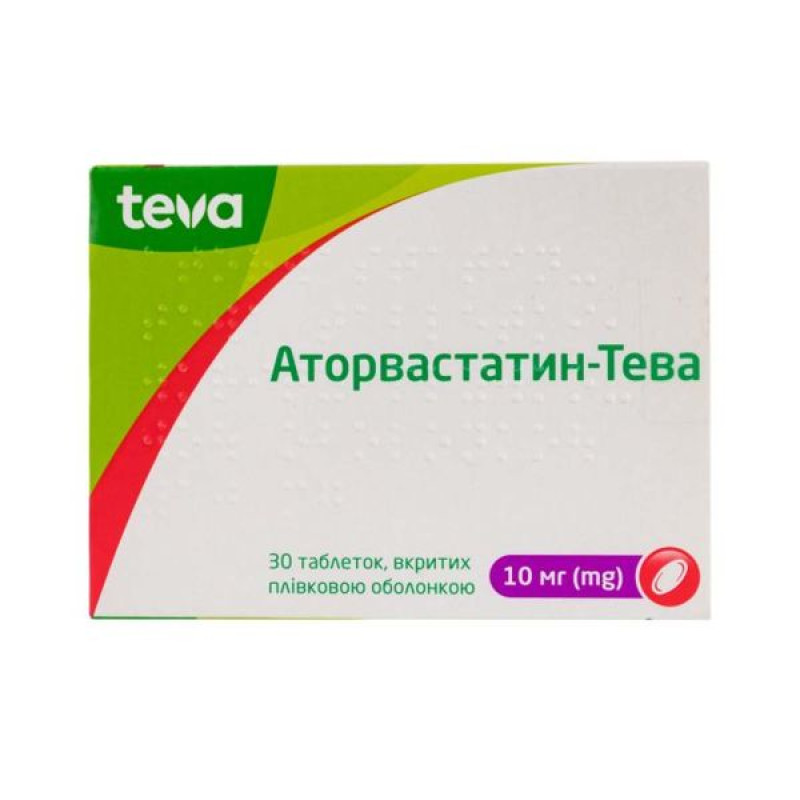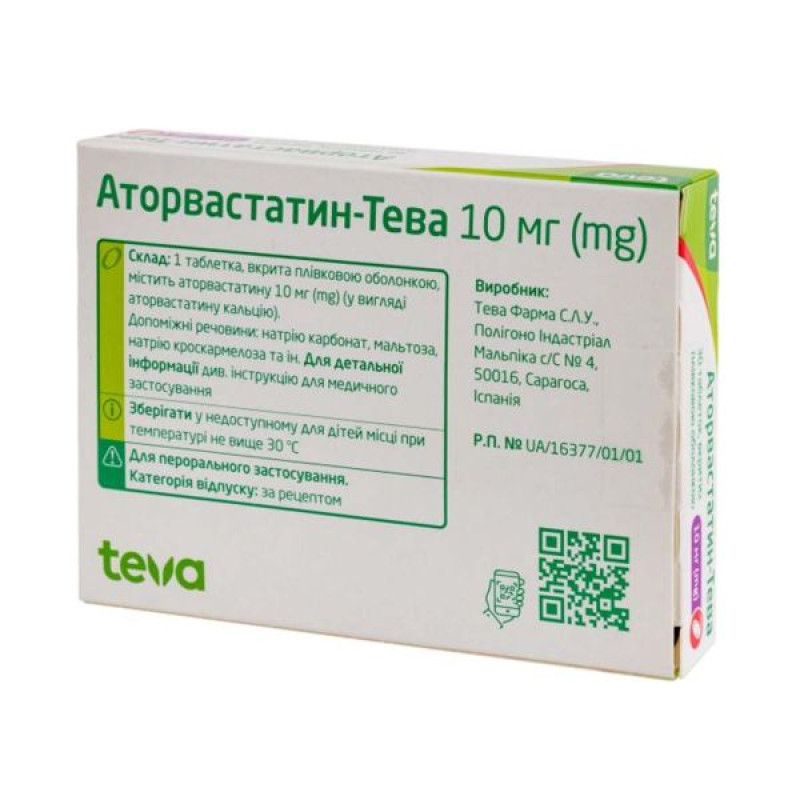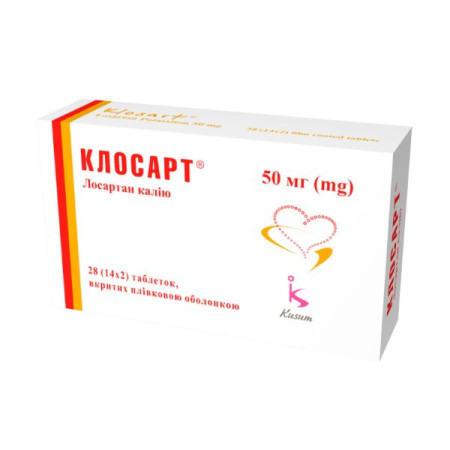Atorvastatin-Teva film-coated tablets 10 mg blister No. 30

Atorvastatin tablets reduce serum cholesterol and triglyceride levels. The drug is indicated for use to reduce the risk of myocardial infarction, stroke, reduce the risk of need for revascularization procedures and angina, reduce the risk of need for hospitalization for congestive heart failure, as an adjunct to diet to reduce elevated total cholesterol, LDL cholesterol, apolipoprotein B, and triglycerides, and to increase HDL cholesterol in patients with primary hypercholesterolemia.
Composition
1 film-coated tablet contains 20 mg of atorvastatin (as atorvastatin calcium); excipients: core: microcrystalline cellulose, sodium carbonate, maltose, croscarmellose sodium, magnesium stearate; coating: hypromellose (E 464), hydroxypropylcellulose, triethyl citrate (E 1505), polysorbate 80, titanium dioxide (E 171).Contraindication
hypersensitivity to any of the components of the drug; active liver disease or persistent elevation of hepatic transaminases of unknown etiology, three times the upper limit of normal; use of the antiviral drug glecaprevir/pibrentasvir for the treatment of hepatitis C; pregnancy and breastfeeding; contraindicated in women of reproductive age not using contraceptives.Method of application
Atorvastatin is for oral use. The dose is taken in full once daily, at any time of the day, regardless of meals.
Before using atorvastatin, the patient should start a standard cholesterol-lowering diet and continue it during treatment with atorvastatin.
The dose is adjusted individually according to the baseline LDL-C level, the goal of therapy and the patient's response. The maximum dose is 80 mg once daily.
The recommended starting dose of atorvastatin is 10 or 20 mg once daily. For patients who require a significant reduction in LDL-C (more than 45%), therapy may be initiated at 40 mg once daily. The dose range for atorvastatin is 10 to 80 mg once daily.
Application features
Pregnant women
Atorvastatin is contraindicated during pregnancy and lactation.
Children
Atorvastatin has not been studied in patients under 10 years of age.
Drivers
Atorvastatin has a minor effect on the reaction rate when driving or operating other mechanisms.
Overdose
There is no specific treatment for atorvastatin overdose. In case of overdose, the patient should be treated symptomatically and, if necessary, supportive measures should be applied. Liver function tests and plasma CPK levels should be monitored. Due to the high degree of binding of the drug to plasma proteins, hemodialysis is not expected to significantly enhance the clearance of atorvastatin.
Side effects
General disorders: malaise, pyrexia, asthenia, chest pain, peripheral edema, fatigue.
Nervous system: headache, dizziness, paresthesia, hypoesthesia, dysgeusia, amnesia; peripheral neuropathy, nightmares, insomnia.
Skin and subcutaneous tissue disorders: urticaria, skin rash, pruritus, alopecia; angioedema, bullous dermatitis (including erythema multiforme), Stevens-Johnson syndrome and toxic epidermal necrolysis.
On the part of the digestive tract: gastrointestinal discomfort, abdominal pain, belching, flatulence, constipation, diarrhea, pancreatitis, nausea, vomiting, dyspepsia.
Storage conditions
Store out of the reach of children at a temperature not exceeding 30 °C.
Shelf life - 2 years.
There are no reviews for this product.
There are no reviews for this product, be the first to leave your review.
No questions about this product, be the first and ask your question.









